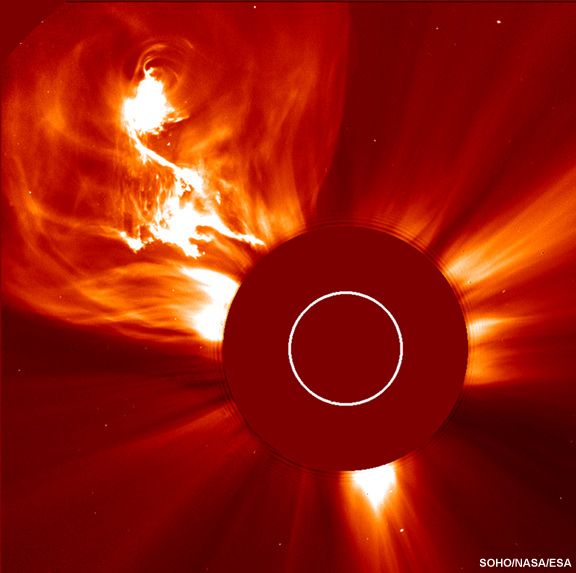150 Years Ago: The Worst Solar Storm Ever

On Sept. 2, 1859, an incredible storm of charged particles sent by the sun slammed into Earth's atmosphere, overpowered it, and caused havoc on the ground. Telegraph wires, the high-tech stuff of the time, suddenly shorted out in the United States and Europe, igniting widespread fires. Colorful aurora, normally visible only in polar regions, were seen as far south as Cuba and Hawaii.
Earth's magnetic field normally protects the surface of the planet from some storms. In 1859, the planet's defenses were totally overwhelmed. Over the past decade, similar but less powerful storms have likewise busted through, giving scientists insight into what will eventually happen again.
The outlook is not rosy.
The solar storm of 1859 was three times more powerful than one that cut power to an entire Canadian province in 1989. Experts say if it happened today – and it could – the result might be unthinkable.
If a storm that severe occurred today, it could cause up to $2 trillion in initial damages by crippling communications on Earth and fueling chaos among residents and even governments in a scenario that would require four to 10 years for recovery, according to a report earlier this year by the National Academy of Sciences. For comparison, hurricane Katrina inflicted somewhere between $80 billion and $125 billion in damage.
The good news is that astronomers know what they're dealing with a little more nowadays and have the ability to forecast solar storms, with the help of sun-watching spacecraft. The storms originate – still largely unpredictably – from dark sunspots. Once the spots erupt, an initial wave of radiation strikes Earth in just minutes. The worst eruptions unleash another cloud of charged particles that billow outward and take anywhere from 18 to 36 hours to reach us; those can be spotted and evaluated on the way, allowing for relatively accurate predictions of arrival time and potency.
Advance warning allows key power-grid switching stations to be turned off for protection. Satellites that might otherwise be knocked out by an electrical short are put into sleep mode.
Get the Space.com Newsletter
Breaking space news, the latest updates on rocket launches, skywatching events and more!
We have the 1859 tempest to thank for ushering in the era of solar storm forecasting.
"The cause of all this [in 1859] was an extraordinary solar flare witnessed the day before by British astronomer Richard Carrington," according to Spaceweather.com. "His sighting marked the discovery of solar flares and foreshadowed a new field of study: space weather."
The sun operates on an 11-year cycle of activity. The next peak is expected in 2013. Forecasters recently revised their prediction for just how powerful that peak might be, downgrading it to mild. But the sun is unpredictable, and even during a mild period of activity – such as right now – major flares can kick up colossal storms.
- Gallery: Solar Storms
- Video - How Space Storms Wreak Havoc on Earth
- The Great Solar Storm of 1859
Join our Space Forums to keep talking space on the latest missions, night sky and more! And if you have a news tip, correction or comment, let us know at: community@space.com.

Rob has been producing internet content since the mid-1990s. He was a writer, editor and Director of Site Operations at Space.com starting in 1999. He served as Managing Editor of LiveScience since its launch in 2004. He then oversaw news operations for the Space.com's then-parent company TechMediaNetwork's growing suite of technology, science and business news sites. Prior to joining the company, Rob was an editor at The Star-Ledger in New Jersey. He has a journalism degree from Humboldt State University in California, is an author and also writes for Medium.









